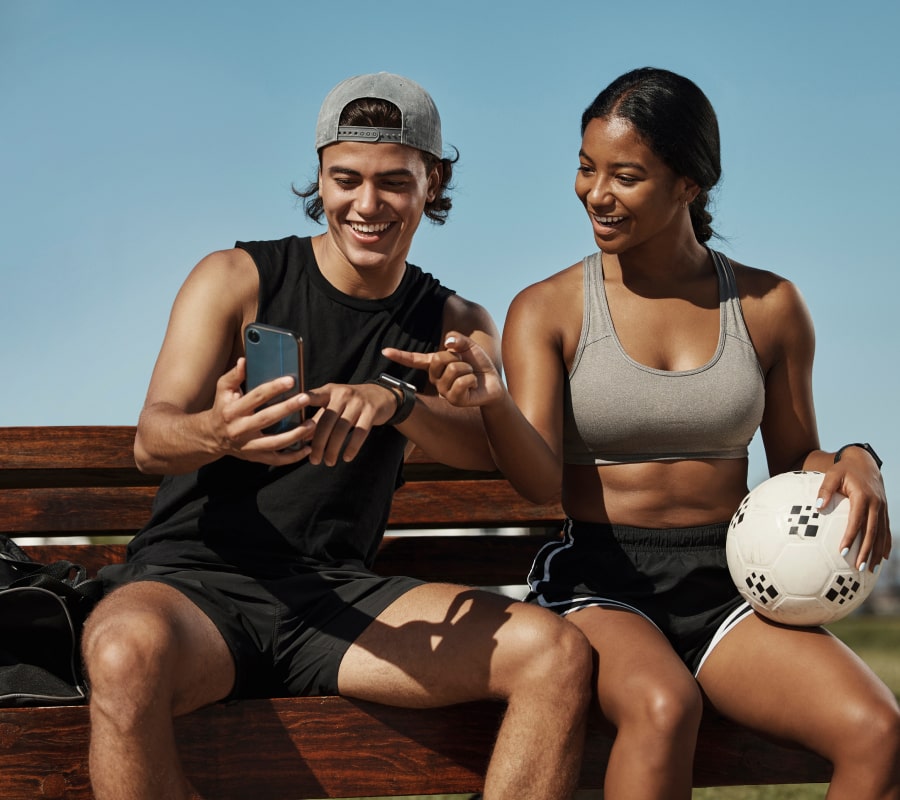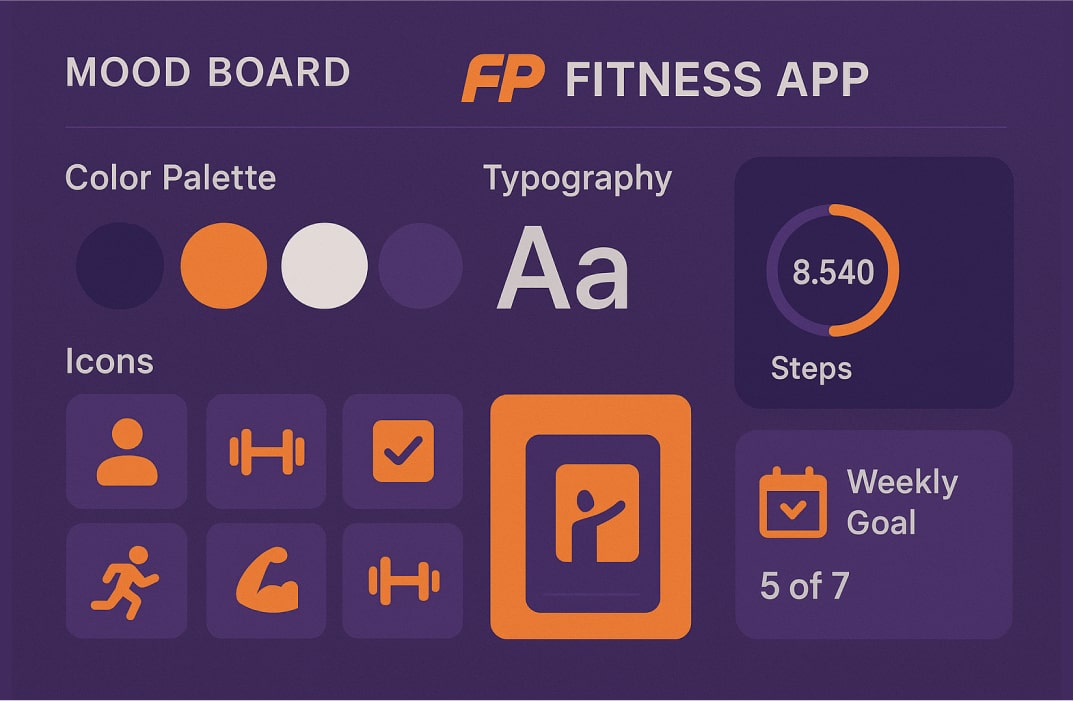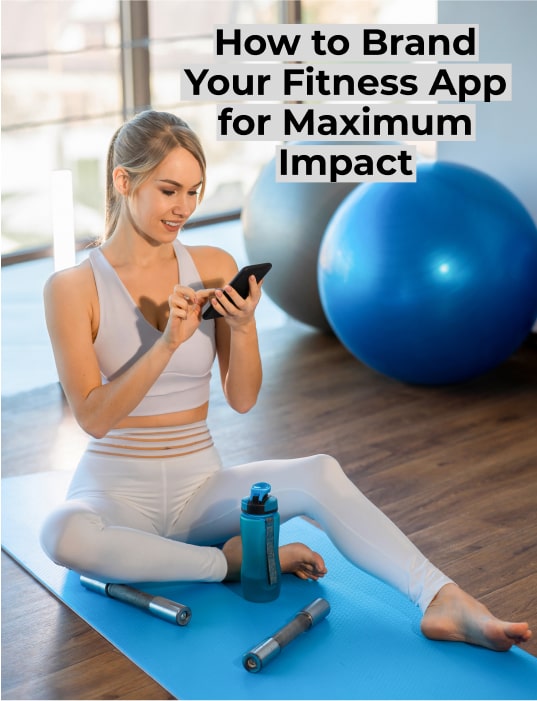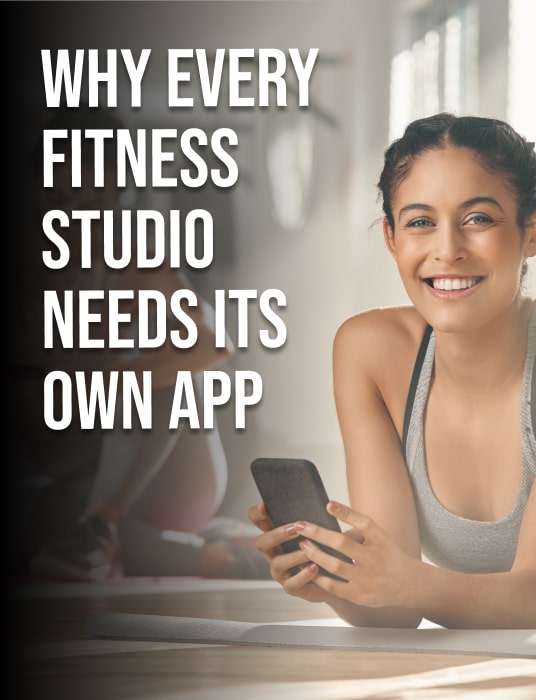Are You Earning Up to Your Potential?
Most personal trainers are undervaluing their time and skills. Our Personal trainer Revenue Calculator helps you find out what you should be making, and how to get there.
No guesswork. Just real numbers.
.jpg)
The fitness app market is exploding with opportunities. Every day, millions of people search for the perfect workout apps to help them achieve their fitness goals. As a fitness coach, trainer, or fitness business owner, creating your own personal trainer app can transform how you connect with clients and grow your brand.
But here's the challenge: the app store is crowded with thousands of mobile fitness apps. How do you make yours stand out? The answer lies in strategic fitness app branding.
Fitness app branding isn't just about picking pretty colors or designing a logo. It's about creating a complete identity that resonates with your target audience and builds lasting relationships with your clients. When done right, effective branding can be the difference between an app that gets lost in the crowd and one that becomes a go-to solution for fitness professionals and their clients.
This comprehensive guide will walk you through everything you need to know about branding your fitness app for maximum impact. Whether you're planning your first fitness app development project or looking to rebrand an existing mobile app, these strategies will help you create a fitness brand that attracts, engages, and retains users.
Understanding the Fitness App Landscape
The Current State of Mobile Fitness Apps
The fitness industry has experienced a digital revolution. Mobile fitness apps have become essential tools for personal trainers, gym owners, and fitness studios. The Apple App Store and Google Play Store combined host over 50,000 fitness-related applications, making it one of the most competitive categories.
Successful apps in the fitness category share common characteristics. They understand their users' needs, provide real value, and maintain consistent branding throughout the user experience. Apps like MyFitnessPal, Nike Training Club, and Peloton didn't succeed by accident. They invested heavily in brand identity and user experience from day one.
Why Branding Matters More Than Ever
In today's saturated fitness app market, features alone aren't enough. Users have countless options for workout tracking, meal planning, and fitness programs. What makes them choose one app over another often comes down to how well the app's brand connects with them emotionally.
Strong fitness app branding helps you:
- Stand out in crowded app stores
- Build trust with potential users
- Create emotional connections with your audience
- Increase client retention rates
- Command premium pricing for your services
The Evolution of Fitness App User Expectations
Modern fitness app users expect more than basic workout plans and tracking features. They want personalized experiences, community connections, and seamless integration with their fitness journey. Your branded fitness app needs to deliver not just functionality, but also an experience that aligns with your users' values and aspirations.

Defining Your Fitness App Brand Identity
Discovering Your Unique Value Proposition
Before diving into visual elements, you need to understand what makes your fitness app different. Your unique value proposition is the foundation of your brand identity. It answers the question: "Why should someone choose your app over the thousands of other options?"
Start by analyzing your expertise as a fitness professional. What specific knowledge, methodology, or approach do you bring to the table? Maybe you specialize in HIIT workouts for busy professionals, or perhaps you've developed a unique approach to strength training for seniors. This expertise becomes the cornerstone of your fitness brand.
Consider your existing client base if you're already working as a personal trainer or running a fitness business. What do they value most about your services? How do they describe their experience working with you? These insights provide valuable clues about how to position your branded app.
Identifying Your Target Audience
Market research is crucial for effective fitness app branding. Your target audience should be clearly defined beyond basic demographics. Dive deep into their motivations, challenges, and preferences.
Are you targeting gym members who want to supplement their in-person workouts? Busy parents who need quick home workouts? Fitness coaches looking for tools to manage clients more effectively? Each audience segment requires different messaging and branding approaches.
Create detailed user personas that include:
- Demographic information (age, income, location)
- Fitness experience level and goals
- Technology comfort level
- Preferred communication styles
- Pain points and motivations
- Social media usage patterns
Crafting Your Brand Personality
Your fitness app needs a personality that resonates with your target users. This personality should reflect your values as a fitness professional while appealing to your audience's aspirations and needs.
Consider whether your brand personality is:
- Motivational and energetic
- Calm and mindful
- Scientific and data-driven
- Community-focused and supportive
- Premium and exclusive
This personality will influence everything from your app's tone of voice to its visual design and key features. Consistency across all touchpoints is essential for building trust and recognition.
💪 Got an idea for a brand? Let's bring it to life.
Launch your own fitness app with FitBudd in minutes!

💪 Got your brand name? Let’s bring it to life.
Launch your own fitness app with FitBudd in minutes!


88% trainers worldwide gave us 5 stars
Transform your fitness business with the power of your branded app on iOS and Android.
Try for FREESetting Brand Guidelines
Once you've defined your brand identity, document it in comprehensive brand guidelines. These guidelines should cover:
- Brand mission and values
- Target audience descriptions
- Brand personality traits
- Voice and tone guidelines
- Visual identity standards
- Usage rules and restrictions
Having clear guidelines ensures consistency as your team grows and your fitness app evolves. It also helps app development teams understand how to implement your vision effectively.
Visual Branding Elements for Fitness Apps
Choosing the Right Brand Colors
Brand colors play a crucial role in fitness app branding. Colors evoke emotions and can significantly impact user behavior and perception. In the fitness industry, color choices should align with the energy and motivation you want to inspire.
Popular color schemes in successful apps include:
- Energetic combinations (orange and red) for high-intensity workouts
- Calming blues and greens for wellness and recovery apps
- Bold, contrasting colors for apps targeting younger demographics
- Sophisticated grays and blacks for premium fitness experiences
Consider the psychological impact of your color choices. Red can increase urgency and motivation, while blue promotes trust and reliability. Green is associated with growth and health, making it popular for wellness-focused apps.
Your color palette should work well across different devices and accessibility requirements. Test your colors on various screen sizes and ensure sufficient contrast for users with visual impairments.
Typography That Motivates
Typography is often overlooked in fitness app design, but it significantly impacts user experience and brand perception. Your font choices should reflect your brand personality while remaining highly readable across different devices and screen sizes.
For fitness apps, consider:
- Bold, strong fonts for headers that convey confidence and energy
- Clean, readable fonts for body text and workout instructions
- Consistent font hierarchies that guide users through your content
- Custom typography that reinforces your unique brand identity
Avoid using too many different fonts, as this can create visual confusion. A well-chosen primary font with one complementary accent font is usually sufficient for most fitness apps.
Logo Design and App Icons
Your logo and app icon are often the first touchpoints users have with your fitness brand. They need to be memorable, scalable, and instantly recognizable. In app stores, your icon competes with hundreds of others for attention.
Effective fitness app icons often incorporate:
- Simple, bold shapes that remain clear at small sizes
- Recognizable fitness symbols (dumbbells, hearts, figures in motion)
- Colors that stand out in the App Store environment
- Minimal text, as it becomes unreadable at small sizes
Your logo should work across various applications, from your app icon to marketing materials and social media profiles. Consider creating different versions optimized for different use cases.
Creating Consistent Visual Language
Branding elements extend beyond colors and fonts to include imagery style, iconography, and interface components. Develop a consistent visual language that reinforces your brand across every screen of your app.
This includes:
- Icon styles (outlined, filled, flat, or dimensional)
- Button and interface element designs
- Image and video treatment guidelines
- Animation and transition styles
- Layout and spacing standards
Consistency in these elements creates a professional, cohesive experience that builds user trust and brand recognition.

User Experience and Brand Alignment
Designing for Your Fitness Audience
User engagement in fitness apps depends heavily on how well the user experience aligns with your brand identity. Your app's interface should reflect your brand personality while making it easy for users to achieve their fitness goals.
Consider how your target audience prefers to interact with technology. Personal trainers might need detailed analytics and client management tools, while casual fitness enthusiasts might prefer simple, intuitive interfaces focused on workout tracking and motivation.
The user experience should reinforce your brand values at every touchpoint. If your brand emphasizes personalization, ensure your app offers extensive customization options. If community is a core value, prioritize social features and community engagement tools.
Onboarding That Builds Brand Connection
First impressions matter enormously in fitness app development. Your onboarding process is an opportunity to introduce new users to your brand personality and demonstrate immediate value.
Effective onboarding sequences:
- Clearly communicate your app's unique value proposition
- Gather information needed for personalization
- Showcase key features that differentiate your app
- Set appropriate expectations for the user journey
- Begin building the user's fitness profile and goals
Keep onboarding concise but comprehensive. Users should understand what makes your fitness app special without feeling overwhelmed by information or lengthy setup processes.
Navigation and Information Architecture
Your app’s navigation structure should reflect how your users think about fitness and align with your overall brand positioning. Whether you're exploring a fitness app idea or deep into fitness app development, intuitive navigation plays a key role in user engagement and satisfaction.
Fitness professionals often design their apps around client management, program delivery, and scheduling — and this is where a robust gym CRM software solution integrates seamlessly.
Consider these navigation approaches:
- Activity-based organization (Workouts, Nutrition, Progress)
- Goal-oriented structure (Lose Weight, Build Muscle, Stay Healthy)
- Role-based navigation (Trainer Tools, Client Portal, Community)
- Journey-focused architecture (Plan, Train, Track, Recover)
Your navigation should make core features easily accessible while supporting advanced functionality for power users. Features like in-app messaging, push notifications, and client engagement tools should integrate seamlessly — without cluttering the main experience — ensuring your personal training app feels both professional and user-friendly.
Personalization and Brand Consistency
Personalized experiences are increasingly expected in mobile fitness apps. However, personalization shouldn't come at the expense of brand consistency. Users should feel that customized content and recommendations still align with your brand values and personality.
Develop personalization features that reinforce your brand:
- Customized workout plans that reflect your training philosophy
- Nutrition plans that align with your approach to healthy eating
- Progress tracking that emphasizes metrics you believe are most important
- Motivational messaging that uses your brand voice and tone
Personalization extends to visual customization as well. Allow users to make the app their own while maintaining your core brand identity through colors, typography, and overall design language.
Content Strategy for Fitness App Branding
Developing Your Brand Voice
Your brand voice is how your fitness app communicates with users across all touchpoints. It should reflect your brand personality while adapting to different contexts and user needs. Fitness professionals often develop their voice through years of client interaction, and this same personality should carry through to their branded fitness app.
Consider these voice characteristics:
- Motivational but not overwhelming
- Knowledgeable without being condescending
- Supportive during challenging moments
- Celebratory for achievements and milestones
- Consistent across all app features and communications
Document your brand voice with specific examples and guidelines. This ensures consistency as your content team grows and helps maintain brand alignment across app development updates and new features.
Educational Content That Builds Authority
Educational content is a powerful tool for establishing your expertise and building user trust. Your fitness app should position you as a knowledgeable authority in your field while providing genuine value to users.
Develop content that:
- Explains the science behind your training programs
- Provides proper form instruction for exercises
- Offers nutrition guidance aligned with fitness goals
- Addresses common fitness myths and misconceptions
- Shares success stories and case studies
This content can take various forms within your app, from detailed exercise descriptions to video content demonstrations and nutrition guides. The key is ensuring all content reflects your brand expertise and personality.
Social Media Integration and Brand Extension
Leverage social media to extend your fitness brand beyond your app. Social media platforms offer opportunities to showcase your expertise, build community, and drive app downloads. Your social media presence should seamlessly align with your app branding.
Develop a social media strategy that:
- Shares valuable fitness tips and insights
- Showcases user success stories and testimonials
- Provides behind-the-scenes content about your fitness philosophy
- Promotes new features and app updates
- Engages with the broader fitness community
Cross-promote between your app and social media channels. Push notifications can alert users to new social content, while social media can drive traffic to specific app features or fitness challenges.
User-Generated Content and Community Building
Community engagement is crucial for long-term success in the fitness app market. Encourage users to create and share content that showcases their journey with your app. User-generated content serves as authentic testimonials while building a sense of community around your fitness brand.
Facilitate user-generated content through:
- Photo and video sharing features within the app
- Fitness challenges that encourage participation
- Social features that let users connect and motivate each other
- Recognition programs that celebrate user achievements
- Integration with popular social media platforms
User-generated content provides social proof that can influence potential users' decisions to download and engage with your custom fitness app.

Mobile fitness app community feed showing users posting workout updates and progress photos, emphasizing the role of branding in community building.
Technical Considerations for Brand Implementation
Native Apps vs. Custom Solutions
The choice between native apps and cross-platform solutions impacts both user experience and branding opportunities. Native apps often provide better performance and more sophisticated branding elements, while cross-platform solutions can reduce development costs and time to market.
For fitness professionals focused on branding, consider:
- Native apps typically offer more design flexibility
- Platform-specific features can enhance user experience
- Native development allows for deeper integration with device capabilities
- Custom animations and transitions may work better in native environments
However, cross-platform solutions have improved significantly and may be sufficient for many fitness app branding needs. If budget is critical, many trainers choose a fitness app development company rather than building in-house.
App Store Optimization and Brand Visibility
Your app store presence is crucial for brand visibility, user acquisition, and the long-term success of your own fitness app. Whether you're launching a brand-new fitness app idea or rebranding your custom branded app, optimizing your listings on the Apple App Store and Google Play Store is key.
Successful workout apps and gym apps use a mix of technical and branding strategies to stand out.
Optimize your app store listing with:
- Compelling app titles that include relevant keywords like "personal training" or "custom workout plans"
- Detailed descriptions that highlight your unique value proposition and what makes your own workout app different
- High-quality screenshots that showcase your branded interface
- Preview videos that demonstrate key features and your brand personality
- Regular updates that show ongoing development and improvement
Your store listing should immediately communicate why your fitness app is not just another one in the crowd, but a unique, results-driven tool for your audience.
Performance and Brand Perception
How your app performs directly shapes how your brand is perceived. Users associate a well-built custom branded app with professionalism and reliability. Even the most compelling fitness concept can be overshadowed by slow load times, bugs, or crashes.
Make sure your own workout app delivers:
- Fast loading times across all features
- Smooth animations and intuitive navigation
- Reliable workout tracking and data syncing
- Consistent performance across iOS and Android
- Timely updates that improve UX and fix bugs
Great performance leads to better reviews, improved rankings, and stronger word-of-mouth in the workout apps space.
Data Security and Brand Trust
Building a trusted own fitness app also means taking data security seriously. Today’s users expect their workout history, personal information, and health data to be protected — especially in gym apps and wellness platforms.
Build brand trust by:
- Sharing clear, transparent privacy policies
- Implementing secure data storage and encrypted transmission
- Performing regular security audits
- Explaining why and how data is used
- Offering control over data preferences and push notifications
Security lapses don’t just impact app functionality — they can harm your reputation and derail your growth. Prioritize trust as much as tech when building your fitness brand.
Monetization and Brand Positioning
Pricing Strategy and Brand Perception
Your pricing strategy communicates volumes about your brand positioning. Fitness apps range from free with advertising to premium subscriptions costing hundreds of dollars annually. Your pricing should align with your brand identity and target audience expectations.
Consider these pricing approaches:
- One time fee for apps targeting users who prefer ownership
- Subscription models for ongoing content and feature updates
- Freemium approaches that showcase value before conversion
- Tiered pricing that serves different user segments
- Premium pricing for exclusive or highly specialized content
Your pricing strategy should reflect the value you provide and position your fitness brand appropriately within the market. Premium pricing can enhance brand perception if supported by superior features and content.
Feature Monetization and Brand Alignment
Key features that require payment should align with your brand values and user expectations. Users should understand why certain features require payment and feel that the value justifies the cost.
Common monetization features in fitness apps include:
- Advanced workout tracking and analytics
- Personalized experiences and custom workout plans
- In app messaging with personal trainers
- Premium video content and instruction
- Advanced nutrition plans and meal planning tools
Ensure that free features provide genuine value while paid features offer clear upgrades that enhance the user experience. Avoid creating artificial limitations that frustrate users or damage brand perception.
Partnership and Integration Opportunities
Strategic partnerships can extend your fitness brand reach while providing additional value to users. Consider partnerships with:
- Wearable device manufacturers for enhanced workout tracking
- Nutrition companies for meal planning integration
- Gym chains for facility access and member benefits
- Other fitness professionals for expanded expertise
- Health and wellness brands for cross-promotion opportunities
Partnerships should align with your brand values and provide genuine value to your users. Poorly chosen partnerships can dilute your brand message or create user confusion.
Long-term Brand Evolution
Plan for brand evolution as your fitness app grows and market conditions change. Successful apps regularly update their branding to stay relevant while maintaining core brand recognition.
Consider how your brand might evolve:
- Expanding into new fitness categories or specializations
- Adding new target audiences or user segments
- Incorporating new technologies or features
- Responding to changing fitness trends and user preferences
- Scaling from local to national or international markets
Establish brand guidelines that allow for evolution while maintaining consistency and recognition among your existing user base.
Marketing Your Branded Fitness App
Launch Strategy and Brand Introduction
Your mobile app launch is your first big opportunity to introduce your fitness brand to the world and establish strong initial relationships with users. Whether you're a personal trainer, own a fitness studio, or are launching a broader fitness solution, a well-executed launch can significantly boost visibility and downloads.
Develop a launch strategy that includes:
- Pre-launch buzz through social media, waitlists, and email marketing
- Collaborations with fitness influencers and trusted personal trainers
- Press releases and media coverage highlighting your brand story and unique value
- Launch-day promotions across all platforms — social, web, and email
- Follow-up campaigns to maintain momentum and user engagement
Your launch messaging should clearly communicate what makes your custom app different from other fitness solutions in the market — emphasizing not just features, but the personalized experience it offers for your clients.
Content Marketing and Thought Leadership
Establishing yourself as a thought leader in the fitness industry is a powerful way to grow your mobile app organically. Strategic content marketing builds credibility and attracts your ideal audience — whether they're individuals looking for expert guidance or fitness studios exploring digital offerings.
Create helpful, insightful content across multiple formats:
- Blog posts that address common fitness challenges or trends
- Videos that demonstrate techniques, workouts, or explainers tailored to your niche
- Podcasts or interviews sharing your perspective as a personal trainer or studio owner
- Infographics that make complex fitness data easy to understand
- Case studies and client stories showing real results from your custom app
Distribute this content across your app, website, and social platforms to build a unified brand presence. This strategy reinforces your authority and shows how your fitness solution delivers real, personalized results — beyond what generic apps offer.
Influencer Partnerships and Brand Advocacy
Partner with fitness professionals, athletes, and wellness influencers who align with your brand values. These partnerships can significantly expand your reach and provide social proof for your fitness app.
When selecting influencer partners, consider:
- Audience alignment with your target users
- Brand values compatibility
- Engagement quality rather than just follower count
- Long-term partnership potential
- Authenticity and genuine interest in your app
Successful influencer partnerships go beyond simple promotions to include authentic integration of your app into the influencer's fitness routine and content strategy.
Community Building and User Advocacy
Transform satisfied users into brand advocates who organically promote your fitness app. Community engagement within your app creates loyal users who are more likely to recommend your app to others.
Foster community through:
- Fitness challenges that encourage participation and sharing
- User recognition programs that celebrate achievements
- Social features that connect users with similar goals
- Exclusive content or features for active community members
- Regular communication that makes users feel valued and heard
Strong communities create network effects that drive organic growth and improve client retention rates.

Measuring Brand Success and User Engagement
Key Performance Indicators for Fitness App Branding
Measuring the success of your fitness app branding efforts requires tracking both quantitative metrics and qualitative feedback. Establish key factors that indicate whether your branding is resonating with users and driving business goals.
Important metrics include:
- App store conversion rates (views to downloads)
- User acquisition costs and lifetime value
- Client retention and engagement rates
- Brand awareness and recognition surveys
- User satisfaction and Net Promoter Scores
- Social media engagement and sentiment
- Revenue per user and monetization effectiveness
Track these metrics consistently to understand how branding changes impact user behavior and business performance.
User Feedback and Brand Perception
Regularly collect user feedback to understand how your fitness brand is perceived and where improvements might be needed. User feedback provides insights that metrics alone cannot capture.
Gather feedback through:
- In-app surveys and feedback forms
- App store reviews and ratings analysis
- Social media monitoring and engagement
- Direct user interviews and focus groups
- Customer support interaction analysis
- Community discussions and user-generated content
Pay particular attention to how users describe your app and brand in their own words. This language can inform future marketing messaging and brand positioning.
Iterative Brand Improvement
Fitness app branding is not a one-time project but an ongoing process of refinement and improvement. Use data and feedback to continuously optimize your brand experience and stay relevant to your users' evolving needs.
Regular brand audits should evaluate:
- Visual consistency across all touchpoints
- Message clarity and brand voice alignment
- User experience and interface design effectiveness
- Content quality and relevance
- Competitive positioning and differentiation
- Technical performance and reliability
Make incremental improvements rather than dramatic changes that might confuse existing users. Test new branding elements with small user groups before implementing them broadly.
Scaling Your Brand for Growth
As your fitness app grows, your branding needs will evolve. Plan for scaling challenges such as:
- Maintaining brand consistency across larger teams
- Adapting branding for new markets or demographics
- Integrating new features while preserving brand identity
- Managing increased customer support and communication needs
- Balancing automation with personal brand touch
Successful scaling requires strong brand guidelines, well-trained team members, and systems that maintain quality as volume increases.
Advanced Branding Strategies
Personalization at Scale
Modern fitness apps must balance personalization with consistent branding. Users expect experiences tailored to their individual needs while still recognizing and connecting with your brand identity.
Implement personalization that enhances rather than replaces your brand:
- Customized workout plans that reflect your training methodology
- Personalized motivational messaging in your brand voice
- Adaptive interfaces that maintain visual brand consistency
- Targeted content recommendations that align with brand values
- Dynamic branding elements that respond to user preferences
Technical expertise is required to implement sophisticated personalization while maintaining brand coherence across all user experiences.
Multi-Platform Brand Consistency
Your fitness brand likely extends beyond your mobile app to include websites, social media, email marketing, and potentially physical locations or events. Maintaining consistency across all these touchpoints is crucial for building strong brand recognition.
Develop systems for:
- Consistent visual identity across all platforms
- Unified messaging and brand voice guidelines
- Coordinated content strategies and publishing schedules
- Integrated user experiences that connect different touchpoints
- Comprehensive brand monitoring and quality control
Consider how users move between different platforms and ensure smooth brand transitions that reinforce rather than confuse their understanding of your fitness brand.
International Brand Expansion
If you plan to expand your fitness app into international markets, consider how your branding might need to adapt while maintaining core brand recognition. Cultural differences can significantly impact brand perception and user behavior.
Research considerations for international expansion:
- Cultural attitudes toward fitness and health
- Local competition and market positioning
- Language and communication style preferences
- Visual design and color associations
- Payment preferences and pricing sensitivity
- Regulatory requirements for health and fitness apps
Successful international branding often requires local adaptation while maintaining global brand consistency and recognition.
Technology Integration and Brand Future
Emerging technologies present both opportunities and challenges for fitness app branding. Consider how technologies like artificial intelligence, virtual reality, wearable integration, and voice interfaces might impact your brand strategy.
Future-proofing your brand involves:
- Flexible brand guidelines that can adapt to new technologies
- Core brand values that transcend specific features or platforms
- Investment in technologies that align with your brand positioning
- User research that anticipates changing expectations and behaviors
- Partnership strategies that expand brand capabilities
Stay informed about fitness industry trends and technology developments that might impact how users interact with fitness brands and apps.
Implementation Roadmap
Phase 1: Foundation Building
Start your fitness app branding journey by establishing solid foundations. This phase typically takes 2-3 months and involves core brand development work.
Key activities include:
- Conducting thorough market research and competitive analysis
- Defining your unique value proposition and brand positioning
- Creating detailed user personas and target audience profiles
- Developing brand personality and voice guidelines
- Designing initial visual identity elements, including colors, typography, and logo
During this phase, resist the temptation to rush into visual design before establishing clear brand strategy. Strong foundations support more effective design and development decisions later.
Phase 2: Design and Development Integration
Once your brand strategy is defined, work closely with your app development team to integrate branding into the user experience. This phase typically takes 3-4 months, depending on app complexity.
Focus areas include:
- Translating brand guidelines into user interface design
- Developing custom branding elements and visual components
- Creating content frameworks that support your brand voice
- Implementing personalization features that reinforce brand identity
- Testing brand elements across different devices and use cases
Maintain close collaboration between branding, design, and development teams to ensure brand vision is accurately implemented in the final product.
Phase 3: Launch and Market Introduction
Your launch phase introduces your fitness brand to the market and establishes initial user relationships. This phase typically spans 1-2 months around your app launch date.
Critical launch activities:
- Coordinating marketing campaigns across all channels
- Monitoring initial user feedback and brand perception
- Optimizing app store presence for maximum visibility
- Engaging with early users to build community and advocacy
- Tracking key metrics and adjusting strategies based on performance
Be prepared to make rapid adjustments based on initial market response while maintaining core brand consistency.
Phase 4: Growth and Optimization
After launch, focus on scaling your brand while continuously optimizing based on user feedback and performance data. This is an ongoing phase that continues throughout your app's lifecycle.
Ongoing optimization includes:
- Regular brand audits and consistency checks
- Content creation and community-building activities
- Feature updates that enhance brand experience
- Partnership development and brand extension opportunities
- International expansion and market development
Successful fitness apps treat branding as an ongoing investment rather than a one-time project. Regular attention to brand development supports long-term growth and user satisfaction.
Key Takeaways
Creating a successful fitness app requires more than great features and functionality. Strong fitness app branding differentiates your app in a crowded market, builds emotional connections with users, and supports long-term business growth.
Essential branding principles for fitness apps:
Your brand identity must reflect your unique expertise and value proposition as a fitness professional. Users choose apps that align with their values and aspirations, not just their functional needs.
Consistency across all touchpoints builds trust and recognition. From your app icon to in-app messaging, every interaction should reinforce your brand personality and values.
User engagement increases when branding aligns with user expectations and needs. Personalized experiences that maintain brand consistency create the strongest user relationships.
Content strategy and educational content establish your authority while providing genuine value. Users are more likely to trust and recommend apps that demonstrate expertise and thought leadership.
Community building and social media integration extend your brand reach while creating network effects that drive organic growth.
Technical expertise and performance directly impact brand perception. Poor performance undermines even the best branding efforts.
Market research and user feedback should continuously inform brand evolution. Successful brands adapt while maintaining core recognition and consistency.
The fitness app market rewards brands that combine functional excellence with emotional connection. Users have countless options for workout tracking and fitness programs. They choose apps that make them feel understood, motivated, and supported in their fitness journey.
Your fitness app branding strategy should evolve as your app grows and market conditions change. Plan for long-term brand development that supports scaling and international expansion.
Remember that branding is an investment in your app's future success. Fitness professionals who prioritize branding alongside functionality create apps that not only attract users but build lasting relationships that drive business growth.
Whether you're developing your first custom fitness app or rebranding an existing solution, these strategies provide a roadmap for creating maximum impact in the competitive fitness industry. Focus on authentic brand development that reflects your expertise and connects with your users' aspirations for a healthier, more active lifestyle.
Frequently Asked Questions
Designing your own fitness app starts with understanding your target audience and defining your brand identity. Your app should reflect your core training philosophy, visual style (colors, logo, fonts), and tone of voice. Think of it as a digital extension of your personal training business or fitness studio. Use a platform like FitBudd to streamline the process — it lets you build a custom-branded fitness app without needing technical skills. Focus on features that matter most to your clients: personalized workout plans, progress tracking, community engagement, and intuitive navigation. Tip: Keep the design user-centric and consistent with your fitness brand across every screen.
Starting your own fitness company begins with identifying your niche — whether it’s personal training, group fitness, yoga, strength training, or online coaching. From there, build a brand around your unique value proposition. Once you’ve established your business model and audience, creating a mobile app can help you scale. A branded fitness app allows you to deliver workouts, connect with clients, and monetize your services more efficiently. Pro tip: A custom fitness app can act as both your marketing and service delivery tool, helping you stand out in a crowded fitness industry.
The cost of building a fitness app can range from $10,000 to $100,000+ if developed from scratch — depending on complexity, platform, and developer rates. However, platforms like FitBudd offer a far more affordable and scalable solution by letting personal trainers and fitness studios launch their own custom-branded app for a monthly subscription, often starting under $100/month. This approach saves time and eliminates the need for a development team while offering features like in-app messaging, push notifications, client tracking, and seamless integrations.
A great fitness brand name should reflect your core values, training style, and audience. It should be easy to remember, relevant to fitness, and aligned with your brand personality — whether that’s energetic, mindful, science-driven, or empowering. When brainstorming, consider what sets your training approach apart. Do you focus on mobility, performance, transformation, or a specific lifestyle? Use those themes as inspiration. Check domain and social handle availability to ensure consistency across your app, website, and social media. Bonus: Once your brand name is set, carry that identity through every aspect of your fitness app branding — from the logo and color palette to your tone of voice and content style.

Ultimate Marketing Guide for Fitness Trainers
Boost your business growth with these tried and tested marketing strategies. Free for you to download.
Download Now
Templates
These functional templates have the power to make any fitness trainer's life easier.
Subscribe To
Our Blog


























